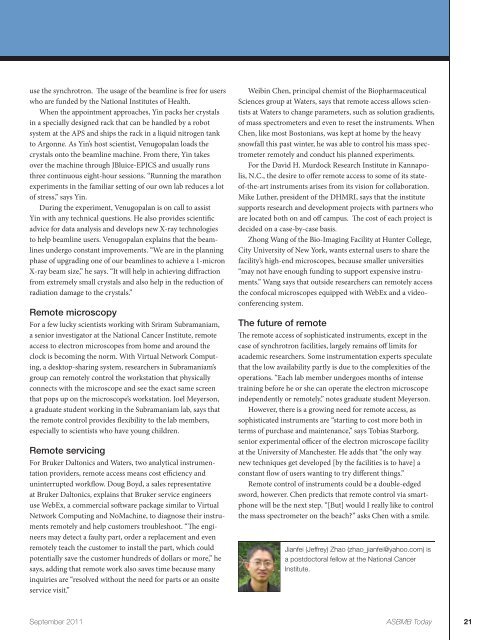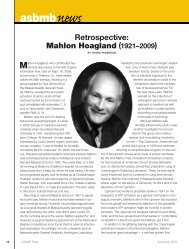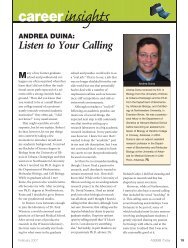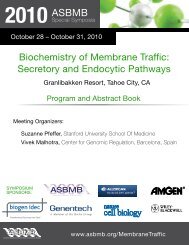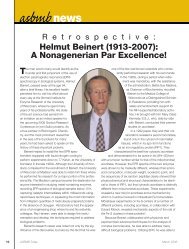asbmbnews
asbmbnews
asbmbnews
Create successful ePaper yourself
Turn your PDF publications into a flip-book with our unique Google optimized e-Paper software.
use the synchrotron. The usage of the beamline is free for users<br />
who are funded by the National Institutes of Health.<br />
When the appointment approaches, Yin packs her crystals<br />
in a specially designed rack that can be handled by a robot<br />
system at the APS and ships the rack in a liquid nitrogen tank<br />
to Argonne. As Yin’s host scientist, Venugopalan loads the<br />
crystals onto the beamline machine. From there, Yin takes<br />
over the machine through JBluice-EPICS and usually runs<br />
three continuous eight-hour sessions. “Running the marathon<br />
experiments in the familiar setting of our own lab reduces a lot<br />
of stress,” says Yin.<br />
During the experiment, Venugopalan is on call to assist<br />
Yin with any technical questions. He also provides scientific<br />
advice for data analysis and develops new X-ray technologies<br />
to help beamline users. Venugopalan explains that the beamlines<br />
undergo constant improvements. “We are in the planning<br />
phase of upgrading one of our beamlines to achieve a 1-micron<br />
X-ray beam size,” he says. “It will help in achieving diffraction<br />
from extremely small crystals and also help in the reduction of<br />
radiation damage to the crystals.”<br />
Remote microscopy<br />
For a few lucky scientists working with Sriram Subramaniam,<br />
a senior investigator at the National Cancer Institute, remote<br />
access to electron microscopes from home and around the<br />
clock is becoming the norm. With Virtual Network Computing,<br />
a desktop-sharing system, researchers in Subramaniam’s<br />
group can remotely control the workstation that physically<br />
connects with the microscope and see the exact same screen<br />
that pops up on the microscope’s workstation. Joel Meyerson,<br />
a graduate student working in the Subramaniam lab, says that<br />
the remote control provides flexibility to the lab members,<br />
especially to scientists who have young children.<br />
Remote servicing<br />
For Bruker Daltonics and Waters, two analytical instrumentation<br />
providers, remote access means cost efficiency and<br />
uninterrupted workflow. Doug Boyd, a sales representative<br />
at Bruker Daltonics, explains that Bruker service engineers<br />
use WebEx, a commercial software package similar to Virtual<br />
Network Computing and NoMachine, to diagnose their instruments<br />
remotely and help customers troubleshoot. “The engineers<br />
may detect a faulty part, order a replacement and even<br />
remotely teach the customer to install the part, which could<br />
potentially save the customer hundreds of dollars or more,” he<br />
says, adding that remote work also saves time because many<br />
inquiries are “resolved without the need for parts or an onsite<br />
service visit.”<br />
Weibin Chen, principal chemist of the Biopharmaceutical<br />
Sciences group at Waters, says that remote access allows scientists<br />
at Waters to change parameters, such as solution gradients,<br />
of mass spectrometers and even to reset the instruments. When<br />
Chen, like most Bostonians, was kept at home by the heavy<br />
snowfall this past winter, he was able to control his mass spectrometer<br />
remotely and conduct his planned experiments.<br />
For the David H. Murdock Research Institute in Kannapolis,<br />
N.C., the desire to offer remote access to some of its stateof-the-art<br />
instruments arises from its vision for collaboration.<br />
Mike Luther, president of the DHMRI, says that the institute<br />
supports research and development projects with partners who<br />
are located both on and off campus. The cost of each project is<br />
decided on a case-by-case basis.<br />
Zhong Wang of the Bio-Imaging Facility at Hunter College,<br />
City University of New York, wants external users to share the<br />
facility’s high-end microscopes, because smaller universities<br />
“may not have enough funding to support expensive instruments.”<br />
Wang says that outside researchers can remotely access<br />
the confocal microscopes equipped with WebEx and a videoconferencing<br />
system.<br />
The future of remote<br />
The remote access of sophisticated instruments, except in the<br />
case of synchrotron facilities, largely remains off limits for<br />
academic researchers. Some instrumentation experts speculate<br />
that the low availability partly is due to the complexities of the<br />
operations. “Each lab member undergoes months of intense<br />
training before he or she can operate the electron microscope<br />
independently or remotely,” notes graduate student Meyerson.<br />
However, there is a growing need for remote access, as<br />
sophisticated instruments are “starting to cost more both in<br />
terms of purchase and maintenance,” says Tobias Starborg,<br />
senior experimental officer of the electron microscope facility<br />
at the University of Manchester. He adds that “the only way<br />
new techniques get developed [by the facilities is to have] a<br />
constant flow of users wanting to try different things.”<br />
Remote control of instruments could be a double-edged<br />
sword, however. Chen predicts that remote control via smartphone<br />
will be the next step. “[But] would I really like to control<br />
the mass spectrometer on the beach?” asks Chen with a smile.<br />
Jianfei (Jeffrey) Zhao (zhao_jianfei@yahoo.com) is<br />
a postdoctoral fellow at the National Cancer<br />
Institute.<br />
September 2011 ASBMB Today 21


